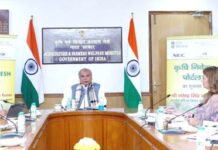Union Agriculture & Farmers’ Welfare Minister, Shri Radha Mohan Singh today on the occasion of National Milk Day said that India is the ‘Oyster’ of the global dairy industry with opportunities galore for the entrepreneurs globally. Since last 15 years, India continues to be the largest producer of milk in the world. This phenomenal increase is contributed to the several measures initiated by the Government of India to increase the productivity of livestock.Shri Singh said that increasing the milk production significantly from 137.7 million tonnes in 2013-14 to 164 million tonnes in 2016-17. Milk production increased by 18.81% in 2016-17 when compared to 2013-14. Similarly, the per capita availability of milk increased from 307 gram in 2013-14 to 351 gram in 2016-17. Annual growth rate of Milk Production during the period 2011-14 was 4%, which has increase to 6% during 2014-17. The annual growth rate of world milk production has increased by 2% during 2014-17.On this occasion the Minister said that Livestock sector contributes significantly towardslivelihoods and security net for the landless and marginal farmers. About 70 million rural households are engaged in dairying in India with 80% of total cow population. The strength of women in Dairy has reached to the 70% of the total work force (about 44 lakh) of which 3,60,000 women are in leadership roles in village dairy cooperatives and 380 women on the boards of Union and State Federations.
Union Agriculture & Farmers’ Welfare Minister said that the consumption of milk is rising, commensurate with increase in the purchasing power of people, increasing urbanization, changing food habits & life styles and demographic growth. Milk with its varied benefits is the only source of animal protein for the largely vegetarian population of the country. Further, factors such as increased consumer interest in high protein diets and increasing awareness & availability of value-added dairy products through organised retail chains are also driving its demand. During last 15 years, Milk Cooperatives have converted about 20% of milk procured into traditional and value added products that offers about 20% higher revenue.This share of value-added products is estimated to increase to 30% by 2021-22.
Shri Singh informed that the Government has initiated a number of dairy development schemes so that the enhanced demand due to variety of factorsis met through domestic sources by laying special focus on raising milk production through improved productivity of our dairy animals. A new scheme “Rashtriya Gokul Mission” has been initiated for the first time in the country under which 18 Gokul Grams in 12 different States are being set up. Also two awards ‘Gopal Ratna Award’ for upkeep of the best dairy animals of indigenous breeds and ‘Kamdhenu Award’ for institutions maintaining best herd of indigenous breeds. This year on World Milk Day 10 Gopal Ratna and 12 Kamdhenu awards have been awarded. Two “National Kamdhenu Breeding Centres” one each in Andhra Pradesh and Madhya Pradesh are being setup for conservation of indigenous breeds. In these centres 41 cattle and 13 buffalo breeds would be conserved. In order to make dairy business more profitable “National Bovine Productivity Mission” has been in initiated with creation of e Pashuhaat portal. This is playing an important role in linking milk producers and breeders for indigenous breeds.Union Agriculture & Farmers’ Welfare Minister further said that a scheme titled Dairy Processing & Infrastructure Development Fund (DIDF) for dairy cooperative sector has been initiated with an outlay of Rs.10881 crore. This scheme would focus on creation of additional milk processing infrastructure and chilling infrastructure through setting up of Bulk Milk Coolers. Also provisions have been made for providing Electronic milk adulteration testing equipment and facilities for manufacturing value added products.Shri singh said that, with gradual shift towards a technology driven environment, there is a great need for adopting advance systems and strengthening the existing one to meet the future challenges. The National Action Plan Vision-2022 is being prepared to fill the gaps in the infrastructure required to handle the increased coverage and milk production not only to meet the demand of milk and milk products but also to fulfil the objective of doubling the farmers’ income.









































